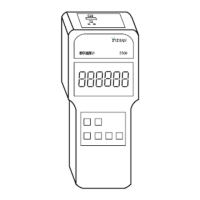
Do you have a question about the Yudian AI-5500 and is the answer not in the manual?
| Output | Linear current: 0-10mA, 4-20mA, Linear voltage: 0-5V, 1-5V |
|---|---|
| Measurement Range | According to the sensor type |
| Resolution | 0.1°C |
| Operating Temperature | 0°C to 50°C |
| Storage Temperature | -10°C to 60°C |
| Battery Type | 9V |
Lists supported thermocouple and RTD types and compensation modes.
Details supported statistical measurement functions.
States settable resolution values and switchable display units.
Describes customizable startup display elements.
Lists additional features like LCD layout, alarms, power consumption, and auto-off.
Table detailing measurement ranges and tolerances for various sensor types.
Explains conditions and units for measurement accuracy and range.
Shows the highest resolution for different sensor types.
Lists sampling rates for different input signals.
Details battery type and operating current.
Specifies operating temperature and humidity ranges.
Provides physical specifications of the device.
Explains the 4-wire connection for RTD sensors with color coding.
Warns against using the 4-wire plug as a USB interface.
Details wiring for thermocouples using interior reference compensation.
Explains wiring for MAN and EXT compensation modes.
Advises on insulation when connecting multiple sensors.
Warns against inputting signals exceeding 5V.
Explains symbols for REL, MAX, MIN, AVG, PP, SN.
Explains LOWBAT, AUTO OFF, OFFSET, HOLD indicators.
Explains unit (°C/°F/K) and sensor type indicators.
Explains INT/EXT/MAN and LOAL/HIAL indicators.
Describes the 6-digit LCD for values and prompts.
Differentiates keys by type and general purpose.
Details power switch, auto-off, backlight control, and auto-off time.
Describes brief press for units and long press for menu access.
Covers selecting math modes and the cancel function.
Explains REL, MAX, MIN, AVG measurement modes.
Explains AVG, P-P, SN calculation and limits.
Details menu navigation using Key 2 and Key 1 combinations.
Describes key combinations for calibration ESC and calibration initiation.
Explains Key 3 for resolution, compensation modes, and decrease function.
Details Key 4 for HOLD, user calibration, and factory restore.
Explains how to enter the menu and navigate parameters.
Describes conditions for saving parameters, including low battery and auto exit.
Parameter for selecting sensor input type.
Parameter to save startup settings.
Parameter to set automatic shut-off duration.
Parameter for backlight auto-off time and buzzer setting.
Parameter for enabling user calibration or restoring factory settings.
Parameter for sensor offset correction.
Parameter for manual TC reference junction temperature setting.
Parameter to set the lower limit for alarms.
Parameter to set the upper limit for alarms.
Explains the tyPE parameter for selecting sensor input type.
Details the ConFig parameter for saving startup settings.
Explains the AutoFF parameter for automatic shut-off duration.
Explains the Auto.b.L parameter for backlight auto-off and buzzer settings.
Explains the CAL.Cod parameter for calibration control.
Explains the OFF.SEt parameter for sensor offset correction.
Explains the mAn.tmp parameter for manual TC reference temperature.
Details setting and behavior of lower and upper limit alarms, including hysteresis.
Outlines conditions and steps before performing calibration.
Details required standard devices and the calibration sequence for Ω and mV points.
Explains the steps for calibrating instrument coefficients using standard signals.
Details the procedure for calibrating interior reference end errors.
Explains how to restore the instrument's factory calibration state and settings.
Explains prompts for parameter setting and calibration code errors.
Explains prompts for resistance (Ω) and voltage (mV) calibration values.
Explains prompts indicating calibration status like CA.FAIL, CAL.ok, ESC.CAL.
Explains prompts for restoring factory settings and their success.
Explains prompts for unstable signals, reference input, and progress.
Explains the OVEr prompt for various errors and limits.
Explains prompts for low, high, or abnormal input signals.
Explains the WrI.Err prompt for errors when saving parameters.
Lists the included K-type thermocouple wire accessory.
Lists various optional accessories such as probes and wires.